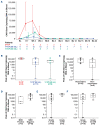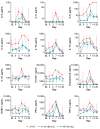Three-year results from phase I of ZUMA-4: KTE-X19 in pediatric relapsed/refractory acute lymphoblastic leukemia
- PMID: 36263840
- PMCID: PMC9973494
- DOI: 10.3324/haematol.2022.280678
Three-year results from phase I of ZUMA-4: KTE-X19 in pediatric relapsed/refractory acute lymphoblastic leukemia
Abstract
Here we present the 3-year results of ZUMA-4, a phase I/II multicenter study evaluating the safety and efficacy of KTEX19, an autologous anti-CD19 chimeric antigen receptor (CAR) T-cell therapy, in pediatric/adolescent patients with relapsed/refractory B-cell acute lymphoblastic leukemia. Phase I explored two dose levels and formulations. The primary endpoint was the incidence of dose-limiting toxicities. Thirty-one patients were enrolled; KTE-X19 was administered to 24 patients (median age 13.5 years, range 3-20; median follow-up 36.1 months). No dose-limiting toxicities were observed. All treated patients had grade ≥3 adverse events, commonly hypotension (50%) and anemia (42%). Grade 3 cytokine release syndrome rates were 33% in all treated patients, 75% in patients given the dose of 2×106 CAR T cells/kg, 27% in patients given the dose of 1×106 cells/kg in the 68 mL formulation, and 22% in patients given the dose of 1×106 cells/kg in the 40 mL formulation; the percentages of patients experiencing grade ≥3 neurologic events were 21%, 25%, 27%, and 11% respectively. Overall complete remission rates (including complete remission with incomplete hematologic recovery) were 67% in all treated patients, 75% in patients given 2×106 CAR T cells/kg, 64% in patients given 1×106 cells/kg in the 68 mL formulation, and 67% in patients given 1×106 cells/kg in the 40 mL formulation. Overall minimal residual diseasenegativity rates were 100% among responders; 88% of responders underwent subsequent allogeneic stem-cell transplantation. In the 1×106 (40 mL) group (recommended phase II dose), the median duration of remission censored at allogeneic stem-cell transplantation and median overall survival were not reached. Pediatric/adolescent patients with relapsed/refractory B-cell acute lymphoblastic leukemia achieved high minimal residual disease-negative remission rates with a manageable safety profile after a single dose of KTE-X19. Phase II of the study is ongoing at the dose of 1×106 CAR T cells/kg in the 40 mL formulation. ClinicalTrials.gov: NCT02625480.
Figures




References
-
- DasGupta RK, Marini BL, Rudoni J, Perissinotti AJ. A review of CD19-targeted immunotherapies for relapsed or refractory acute lymphoblastic leukemia. J Oncol Pharm Pract. 2018;24(6):453-467. - PubMed
-
- Hunger SP, Mullighan CG. Acute lymphoblastic leukemia in children. N Engl J Med. 2015;373(16):1541-1552. - PubMed
-
- Crotta A, Zhang J, Keir C. Survival after stem-cell transplant in pediatric and young-adult patients with relapsed and refractory B-cell acute lymphoblastic leukemia. Curr Med Res Opin. 2018;34(3):435-440. - PubMed
Publication types
MeSH terms
Substances
Associated data
LinkOut - more resources
Full Text Sources
Medical

